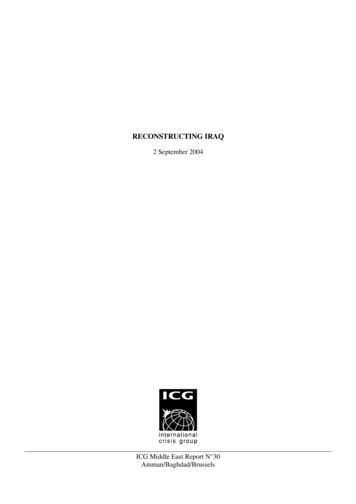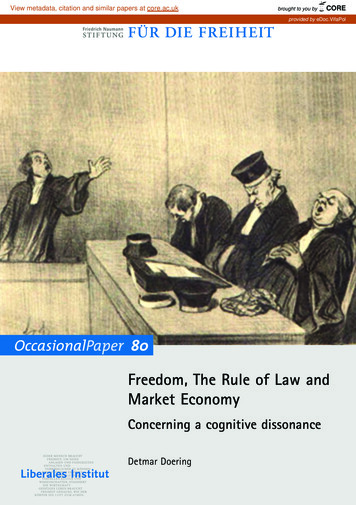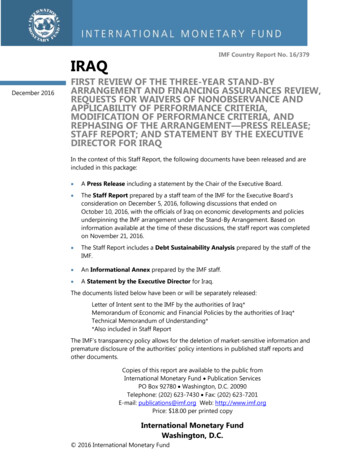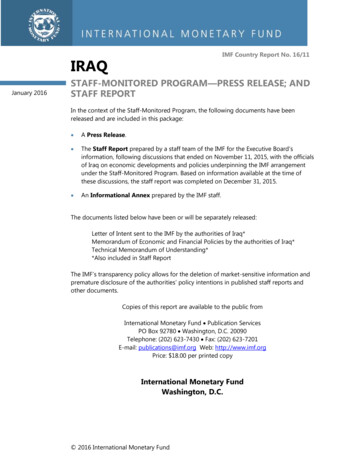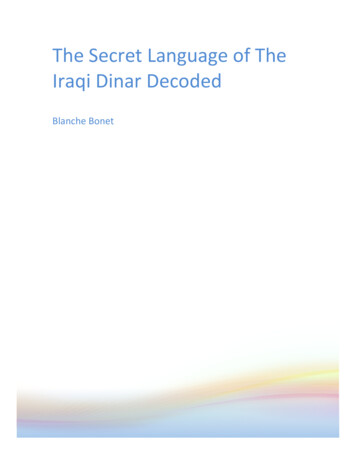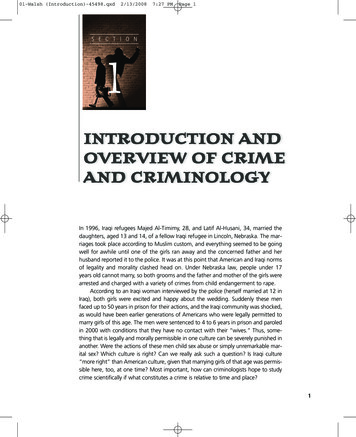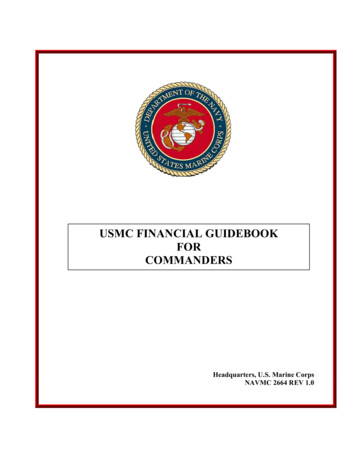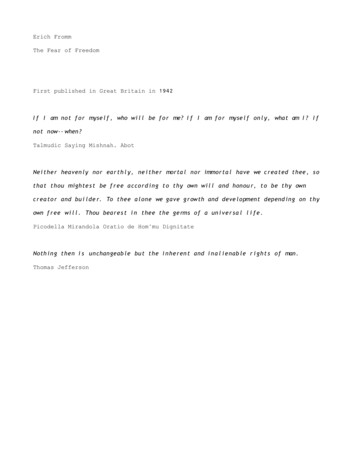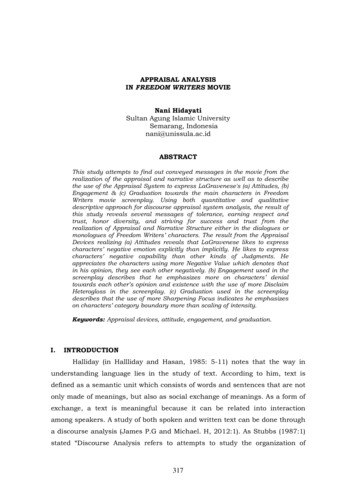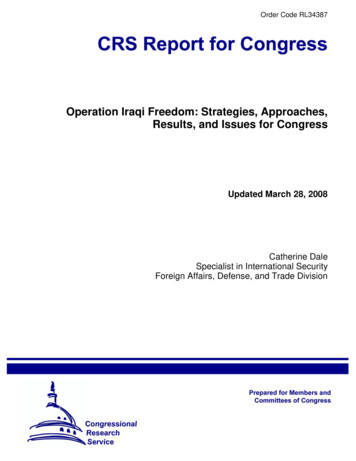
Transcription
Order Code RL34387Operation Iraqi Freedom: Strategies, Approaches,Results, and Issues for CongressUpdated March 28, 2008Catherine DaleSpecialist in International SecurityForeign Affairs, Defense, and Trade Division
Operation Iraqi Freedom: Strategies, Approaches,Results, and Issues for CongressSummaryOperation Iraqi Freedom (OIF) was launched on March 20, 2003. Theimmediate goal, as stated by the Bush Administration, was to remove the regime,including destroying its ability to use weapons of mass destruction or to make themavailable to terrorists. The broad, longer-term objective included helping Iraqis build“a new Iraq that is prosperous and free.”1 In October 2002, Congress had authorizedthe President to use force against Iraq, to “defend the national security of the UnitedStates against the continuing threat posed by Iraq,” and to “enforce all relevantUnited Nations Security Council resolutions regarding Iraq.”2Over time, the focus of OIF has shifted from regime removal to the more openended mission of helping an emerging new Iraqi leadership improve security,establish a system of governance, and foster economic development. With that shiftin focus, the character of the war has evolved from major combat operations to amultifaceted counter-insurgency and reconstruction effort.The next major marker in the development of U.S. Iraq strategy and practice islikely to be the update reports to the Congress from U.S. Ambassador to Iraq RyanCrocker and Commanding General of the Multi-National Force-Iraq (MNF-I)General David Petraeus, scheduled for April 8 and 9, 2008. A second major markeris a security agreement between the governments of the United States and Iraq,expected to be achieved by July 31, 2008, and to include the parameters for thepresence of U.S. personnel in Iraq after December 31, 2008.The most important short-term OIF issue for the Congress concerns the nextsteps after the surge — the military strategies and approaches to be adopted in Iraqafter U.S. forces draw down to the pre-surge level. How OIF experiences to date areevaluated — including policy decision-making, planning, and execution of both themajor combat and post-major combat efforts — are likely to have a significantbearing not only on further U.S. government decisions about Iraq policy, but also onbroader, longer-term U.S. strategic concerns. Some of these include the future U.S.military footprint in Iraq, Iraq as a U.S. national security concern, the future of theU.S. military force, and the distribution of roles and responsibilities among U.S.government agencies in complex contingencies.This report is designed to provide background and analysis of Operation IraqiFreedom to support consideration of these short-term and long-term issues.1See “President Bush Address to the Nation, March 17, 2003,” the televised speech thatincluded a 48-hour ultimatum to Saddam Hussein and his sons, available /20030317-7.html].2See “Authorization for Use of Military Force Against Iraq Resolution of 2002,” H.J.Res.114, Section 3(a), signed into law on October 16, 2002, (P.L.107-243). The Senate vote was77-23, and the House vote 296-133.
ContentsIntroduction . . . . . . . . . . . . . . . . . . . . . . . . . . . . . . . . . . . . . . . . . . . . . . . . . . . . . . 1Upcoming Events . . . . . . . . . . . . . . . . . . . . . . . . . . . . . . . . . . . . . . . . . . . . . . 1Issues for Congress . . . . . . . . . . . . . . . . . . . . . . . . . . . . . . . . . . . . . . . . . . . . 2Short-term Issues: Post-Surge Options . . . . . . . . . . . . . . . . . . . . . . . . . 2Longer-term Issues . . . . . . . . . . . . . . . . . . . . . . . . . . . . . . . . . . . . . . . . . 4Structure and Aim of the Report . . . . . . . . . . . . . . . . . . . . . . . . . . . . . . . . . . 5Decision to Go to War in Iraq . . . . . . . . . . . . . . . . . . . . . . . . . . . . . . . . . . . . . . . . 6Antecedents in the 1990s . . . . . . . . . . . . . . . . . . . . . . . . . . . . . . . . . . . . . . . . 6Bush Administration Strategy and Role of the United Nations . . . . . . . . . . . 7Ultimatum to Saddam Hussein . . . . . . . . . . . . . . . . . . . . . . . . . . . . . . . . . . . 8War Planning . . . . . . . . . . . . . . . . . . . . . . . . . . . . . . . . . . . . . . . . . . . . . . . . . . . . . 8Strategic Objectives . . . . . . . . . . . . . . . . . . . . . . . . . . . . . . . . . . . . . . . . . . . . 9Military Objectives . . . . . . . . . . . . . . . . . . . . . . . . . . . . . . . . . . . . . . . . . . . 10Planning for Major Combat . . . . . . . . . . . . . . . . . . . . . . . . . . . . . . . . . . . . . 10Post-War Planning . . . . . . . . . . . . . . . . . . . . . . . . . . . . . . . . . . . . . . . . . . . . 13Inter-Agency Post-War Planning . . . . . . . . . . . . . . . . . . . . . . . . . . . . . 14Military Post-War Planning . . . . . . . . . . . . . . . . . . . . . . . . . . . . . . . . . 16Organizational Decisions . . . . . . . . . . . . . . . . . . . . . . . . . . . . . . . . . . . 17Major Combat Operations . . . . . . . . . . . . . . . . . . . . . . . . . . . . . . . . . . . . . . . . . . 18Early Infiltration . . . . . . . . . . . . . . . . . . . . . . . . . . . . . . . . . . . . . . . . . . . . . . 19The Launch . . . . . . . . . . . . . . . . . . . . . . . . . . . . . . . . . . . . . . . . . . . . . . . . . 19The Ground Campaign . . . . . . . . . . . . . . . . . . . . . . . . . . . . . . . . . . . . . . . . . 20Iraqi Contributions to Major Combat . . . . . . . . . . . . . . . . . . . . . . . . . . . . . 22End of Major Combat . . . . . . . . . . . . . . . . . . . . . . . . . . . . . . . . . . . . . . . . . 23Post-Major Combat: Basis and Organization . . . . . . . . . . . . . . . . . . . . . . . . . . . 24Legal Basis for Coalition Presence . . . . . . . . . . . . . . . . . . . . . . . . . . . . . . . 24Formal Occupation . . . . . . . . . . . . . . . . . . . . . . . . . . . . . . . . . . . . . . . . 24Iraqi Request for a Multinational Force . . . . . . . . . . . . . . . . . . . . . . . . 25Future Security Framework Agreement . . . . . . . . . . . . . . . . . . . . . . . . 26Coalition Command Relationships . . . . . . . . . . . . . . . . . . . . . . . . . . . . . . . 27Post-Major Combat: The Force . . . . . . . . . . . . . . . . . . . . . . . . . . . . . . . . . . . . . . 29Structure and Footprint . . . . . . . . . . . . . . . . . . . . . . . . . . . . . . . . . . . . . . . . 29Headquarters Organization . . . . . . . . . . . . . . . . . . . . . . . . . . . . . . . . . 29Provincial Iraqi Control . . . . . . . . . . . . . . . . . . . . . . . . . . . . . . . . . . . . 30U.S. Forces in Iraq . . . . . . . . . . . . . . . . . . . . . . . . . . . . . . . . . . . . . . . . . . . . 30Coalition Partner Forces . . . . . . . . . . . . . . . . . . . . . . . . . . . . . . . . . . . . . . . 32Post-Major Combat: Security Situation . . . . . . . . . . . . . . . . . . . . . . . . . . . . . . . . 35Major Sources and Forms of Violence . . . . . . . . . . . . . . . . . . . . . . . . . . . . 35Sunni Extremism . . . . . . . . . . . . . . . . . . . . . . . . . . . . . . . . . . . . . . . . . 35Shi’a Extremism . . . . . . . . . . . . . . . . . . . . . . . . . . . . . . . . . . . . . . . . . 36Nature of Sectarian Violence . . . . . . . . . . . . . . . . . . . . . . . . . . . . . . . . 38Criminality . . . . . . . . . . . . . . . . . . . . . . . . . . . . . . . . . . . . . . . . . . . . . . 38
Other Security Challenges . . . . . . . . . . . . . . . . . . . . . . . . . . . . . . . . . . . . . . 38Kurdistan Workers Party (PKK) . . . . . . . . . . . . . . . . . . . . . . . . . . . . . 39Mujahedin-e Khalq (MeK) . . . . . . . . . . . . . . . . . . . . . . . . . . . . . . . . . 39Post-Major Combat: Military Strategy and Operations . . . . . . . . . . . . . . . . . . . . 40Nomenclature: Characterizing the Conflict . . . . . . . . . . . . . . . . . . . . . . . . . 40Military Operations During Occupation . . . . . . . . . . . . . . . . . . . . . . . . . . . 41Operation Phantom Fury (Fallujah II) . . . . . . . . . . . . . . . . . . . . . . . . . . . . . 44Counter-Insurgency in Tal Afar . . . . . . . . . . . . . . . . . . . . . . . . . . . . . . . . . . 46“Clear, Hold, Build” . . . . . . . . . . . . . . . . . . . . . . . . . . . . . . . . . . . . . . . . . . 48Operation Together Forward . . . . . . . . . . . . . . . . . . . . . . . . . . . . . . . . . . . . 50New Way Forward . . . . . . . . . . . . . . . . . . . . . . . . . . . . . . . . . . . . . . . . . . . . 51“New Way Forward” National Strategy: Theory of the Case . . . . . . . 51Surge Forces . . . . . . . . . . . . . . . . . . . . . . . . . . . . . . . . . . . . . . . . . . . . . 52Surge Military Strategy: Theory of the Case . . . . . . . . . . . . . . . . . . . . 53Surge Operations . . . . . . . . . . . . . . . . . . . . . . . . . . . . . . . . . . . . . . . . . 56Counter-IED Efforts . . . . . . . . . . . . . . . . . . . . . . . . . . . . . . . . . . . . . . . 58Special Operations Forces in the Surge . . . . . . . . . . . . . . . . . . . . . . . . 59The Use of Air Power in the Surge . . . . . . . . . . . . . . . . . . . . . . . . . . . 59Iraqi Security Forces (ISF) . . . . . . . . . . . . . . . . . . . . . . . . . . . . . . . . . . . . . . . . . . 61Requirement for New Iraqi Security Forces . . . . . . . . . . . . . . . . . . . . . . . . 61ISF Training Efforts During the Formal Occupation . . . . . . . . . . . . . . . . . . 62Unity of Effort: Creation of Multi-National Security TransitionCommand-Iraq . . . . . . . . . . . . . . . . . . . . . . . . . . . . . . . . . . . . . . . . . . . 64ISF Training: Theory of the Case . . . . . . . . . . . . . . . . . . . . . . . . . . . . . . . . . 65ISF Training: Organizational Structure and Responsibilities . . . . . . . . . . . 66ISF Training: Transition Teams . . . . . . . . . . . . . . . . . . . . . . . . . . . . . . . . . . 67Iraqi Security Forces: The Numbers . . . . . . . . . . . . . . . . . . . . . . . . . . . . . . 70Iraqi Security Forces: Evaluating the Results . . . . . . . . . . . . . . . . . . . . . . . 71Iraqi Security Forces as a Whole . . . . . . . . . . . . . . . . . . . . . . . . . . . . . 71Iraqi Army . . . . . . . . . . . . . . . . . . . . . . . . . . . . . . . . . . . . . . . . . . . . . . 73Iraqi Air Force . . . . . . . . . . . . . . . . . . . . . . . . . . . . . . . . . . . . . . . . . . . 76Iraqi Navy . . . . . . . . . . . . . . . . . . . . . . . . . . . . . . . . . . . . . . . . . . . . . . . 77Iraqi Special Operations Forces . . . . . . . . . . . . . . . . . . . . . . . . . . . . . . 78Iraqi Police Service . . . . . . . . . . . . . . . . . . . . . . . . . . . . . . . . . . . . . . . 78Iraqi National Police . . . . . . . . . . . . . . . . . . . . . . . . . . . . . . . . . . . . . . 79Department of Border Enforcement . . . . . . . . . . . . . . . . . . . . . . . . . . . 81Ministry of the Interior . . . . . . . . . . . . . . . . . . . . . . . . . . . . . . . . . . . . . 82Ministry of Defense . . . . . . . . . . . . . . . . . . . . . . . . . . . . . . . . . . . . . . . 83Iraqi Population: “Reconciliation” . . . . . . . . . . . . . . . . . . . . . . . . . . . . . . . . . . . . 84Coalition Outreach to the Disaffected . . . . . . . . . . . . . . . . . . . . . . . . . . . . . 84“Awakening” Movements . . . . . . . . . . . . . . . . . . . . . . . . . . . . . . . . . . . . . . 86Origins of the Awakening Movement in Al Anbar . . . . . . . . . . . . . . . 86Spread of the Awakening Movements to the North . . . . . . . . . . . . . . . 87Spread of the Awakening Movements to the South . . . . . . . . . . . . . . . 87Security Volunteers and “Sons of Iraq” . . . . . . . . . . . . . . . . . . . . . . . . . . . . 88Who the “Sons of Iraq” Are . . . . . . . . . . . . . . . . . . . . . . . . . . . . . . . . . 88Origins of the “Sons of Iraq” Movement . . . . . . . . . . . . . . . . . . . . . . . 89How the “Sons of Iraq” System Works . . . . . . . . . . . . . . . . . . . . . . . . 89Security Volunteers in Al Anbar: Provincial Security Force . . . . . . . . 90
Concerns About the “Sons of Iraq” . . . . . . . . . . . . . . . . . . . . . . . . . . . 91“Sons of Iraq” Integration into Permanent Jobs . . . . . . . . . . . . . . . . . . 92Detainee Operations . . . . . . . . . . . . . . . . . . . . . . . . . . . . . . . . . . . . . . . . . . . 94Accountability . . . . . . . . . . . . . . . . . . . . . . . . . . . . . . . . . . . . . . . . . . . 94“COIN Inside the Wire” Detainee Program . . . . . . . . . . . . . . . . . . . . . 94Detainee Releases . . . . . . . . . . . . . . . . . . . . . . . . . . . . . . . . . . . . . . . . 95Civil/Military Partnership in Governance and Economics . . . . . . . . . . . . . . . . . 95Civil/Military Partnership in Iraq: Background . . . . . . . . . . . . . . . . . . . . . 96Provincial Reconstruction Teams . . . . . . . . . . . . . . . . . . . . . . . . . . . . . . . . 96Coordination Between PRTs and Military Units . . . . . . . . . . . . . . . . . . . . . 98Military Role in Governance and Economics . . . . . . . . . . . . . . . . . . . . . . . 99Governance . . . . . . . . . . . . . . . . . . . . . . . . . . . . . . . . . . . . . . . . . . . . 100Economics . . . . . . . . . . . . . . . . . . . . . . . . . . . . . . . . . . . . . . . . . . . . . 101Assessing the Results to Date . . . . . . . . . . . . . . . . . . . . . . . . . . . . . . . . . . . . . . 103Security Situation by Metrics . . . . . . . . . . . . . . . . . . . . . . . . . . . . . . . . . . . 103Overall Attacks . . . . . . . . . . . . . . . . . . . . . . . . . . . . . . . . . . . . . . . . . 103Iraqi Civilian Deaths . . . . . . . . . . . . . . . . . . . . . . . . . . . . . . . . . . . . . 104Weapons Caches . . . . . . . . . . . . . . . . . . . . . . . . . . . . . . . . . . . . . . . . 104High-Profile Attacks . . . . . . . . . . . . . . . . . . . . . . . . . . . . . . . . . . . . . 105Improvised Explosive Devices (IEDs) . . . . . . . . . . . . . . . . . . . . . . . . 105Security Situation: Commanders’ Qualitative Assessments . . . . . . . . . . . 106Security Improvement: Commanders’ Explanations . . . . . . . . . . . . . . . . . 107Security Benchmarks . . . . . . . . . . . . . . . . . . . . . . . . . . . . . . . . . . . . . . . . . 108Theory of the Case: Improved Security Creates Opportunitiesfor Progress? . . . . . . . . . . . . . . . . . . . . . . . . . . . . . . . . . . . . . . . . . . . 111Post-Surge Options . . . . . . . . . . . . . . . . . . . . . . . . . . . . . . . . . . . . . . . . . . . . . . 112Conditions-Based Further Decision-Making . . . . . . . . . . . . . . . . . . . . . . . 112Withdrawal According to a Timeline . . . . . . . . . . . . . . . . . . . . . . . . . . . . . 114Adjustments to the Mission . . . . . . . . . . . . . . . . . . . . . . . . . . . . . . . . . . . . 115Emphasize Counter-Terrorism . . . . . . . . . . . . . . . . . . . . . . . . . . . . . . 116Emphasize Iraqi Security Forces Training . . . . . . . . . . . . . . . . . . . . . 116Emphasize Civilian-Led Governance and EconomicRehabilitation . . . . . . . . . . . . . . . . . . . . . . . . . . . . . . . . . . . . . . . 117Additional CRS Reports . . . . . . . . . . . . . . . . . . . . . . . . . . . . . . . . . . . . . . . . . . 118List of FiguresFigure 1. Map of Iraq . . . . . . . . . . . . . . . . . . . . . . . . . . . . . . . . . . . . . . . . . . . . 119List of TablesTable 1. Iraqi Security Forces as of March 19, 2008 . . . . . . . . . . . . . . . . . . . . . . 70Table 2. Benchmark Assessments as of September 2007 . . . . . . . . . . . . . . . . . 109
Operation Iraqi Freedom: Strategies,Approaches, Results, and Issues forCongressIntroductionOperation Iraqi Freedom (OIF) was launched on March 20, 2003. Theimmediate goal, as stated by the Bush Administration, was to remove the regime,including destroying its ability to use weapons of mass destruction or to make themavailable to terrorists. The broad, longer-term objective included helping Iraqis build“a new Iraq that is prosperous and free.”3 In October 2002, Congress had authorizedthe President to use force against Iraq, to “defend the national security of the UnitedStates against the continuing threat posed by Iraq,” and to “enforce all relevantUnited Nations Security Council resolutions regarding Iraq.”4Over time, the focus of OIF has shifted from regime removal to the more openended mission of helping an emerging new Iraqi leadership improve security,establish a system of governance, and foster economic development. With that shiftin focus, the character of the war has evolved from major combat operations to amultifaceted counter-insurgency and reconstruction effort.Operation Iraqi Freedom is ongoing. While conventional, force-on-force warstend to end with the unequivocal defeat of one party, the parameters for “missionsuccess” in counter-insurgency efforts like OIF tend to be less definitive and moresubject to qualitative interpretation. Therefore, OIF is more likely to end with apolicy decision by the U.S. or Iraqi Government, or both, rather than a decisivemilitary decision on the battlefield.Upcoming EventsThe next major marker in the development of U.S. Iraq strategy and practice islikely to be the update reports to the Congress from U.S. Ambassador to Iraq RyanCrocker and Commanding General of the Multi-National Force-Iraq (MNF-I)General David Petraeus, scheduled for April 8 and 9, 2008. General Petraeus isexpected to make a recommendation concerning further troop withdrawals after troop3See “President Bush Address to the Nation, March 17, 2003,” the televised speech thatincluded a 48-hour ultimatum to Saddam Hussein and his sons, available /20030317-7.html].4See “Authorization for Use of Military Force Against Iraq Resolution of 2002,” H.J.Res.114, Section 3(a), signed into law on October 16, 2002, (P.L.107-243). The Senate vote was77-23, and the House vote 296-133.
CRS-2levels in Iraq return to their pre-“surge” levels in summer 2008.5MNFI’srecommendations to the President may be balanced by input from U.S. CentralCommand, responsible for the entire region including ongoing operations inAfghanistan; from the three Military Departments whose U.S. Code Title Xresponsibilities to “organize, man, train and equip” the force encourage a concernwith sustainability over time, including recruiting and retaining the force; and fromthe Department of Defense as a whole, with responsibility to balance OIF withpreparations to meet all current and likely future security threats to the United States.A second major marker is a security agreement between the governments of theUnited States and Iraq, expected to be achieved by July 31, 2008, and to include theparameters for the presence of U.S. personnel in Iraq after December 31, 2008. Basedon public statements by Secretary of Defense Robert Gates and Secretary of StateCondoleezza Rice, and Congressional testimony from both Departments, theagreement is not expected to contain a commitment to protect and defend Iraq. Thisagreement could shape options available for post-surge OIF strategies andapproaches, as well as for a potential longer-term U.S. force presence.Issues for CongressHow OIF experiences and lessons to date are evaluated — including policydecision-making, planning, and execution of both the major combat and post-majorcombat efforts — are likely to have a significant bearing not only on further U.S.government decisions about Iraq policy, but also on broader, longer-term U.S.strategic concerns.Short-term Issues: Post-Surge Options. The most important short-termOIF policy issue concerns the next steps after the surge — the military strategies andapproaches to be adopted in Iraq after U.S. forces draw down to the pre-surge level.Several major options have been advanced.Conditions-Based Further Decision-Making. The first option is a“conditions-based” approach, generally favored by military commanders in Iraq. Itenvisages using the post-surge forces in Iraq to continue the same full spectrum ofefforts — combat operations, training and mentoring Iraqi security forces, andsupporting efforts to strengthen governance and foster economic reconstruction. Thegoal of U.S. forces in each geographical area would continue to be transitioning theirrelationship with Iraqi counterparts from leadership, to partnership, to overwatch.6Further decisions about U.S. force levels and missions in Iraq would be based onperiodic future assessments of progress.5The “surge” refers to a new set of military and civilian approaches, announced by PresidentBush in a January 10, 2007, Address to the Nation, see rint/20070110-7.html]. It included a U.S. troop level increase fromabout 135,000 in January 2007, to about 168,000 at its peak in October. See “U.S. Forcesin Iraq”, and “New Way Forward,” below.6See General David Petraeus, Report to Congress on the Situation in Iraq, House ForeignAffairs Committee website, .pdf].
CRS-3During a February 2008 visit to Iraq, Secretary of Defense Robert Gatesappeared to support this approach, at least for the near term. Affirming the idea ofa “pause” once the pre-surge troop level is reached, he noted: “I think that the notionof a brief period of consolidation and evaluation probably does make sense.”7 Andspeaking at the Pentagon on the fifth anniversary of the launch of OIF, PresidentBush stated: “Any further drawdown will be based on conditions on the ground andthe recommendations of our commanders.”8Withdrawal According to a Timeline. A second major option is to drawdown all remaining U.S. forces in Iraq by a set deadline, or in accordance with a setschedule — for example, as some have proposed, by one Brigade Combat Team permonth. This option is typically less focused on achieving some particular endstatein Iraq, than on bringing the U.S. military commitment in Iraq to a close, or onrelieving stress on the U.S. military as a whole.Adjustments to the Mission. A third family of options would adjust theU.S. mission in Iraq by enhancing certain efforts while drawing down mostconventional forces. Such proposals aim simultaneously at achieving “missionsuccess” in Iraq and accelerating the return home of U.S. forces. Proposals voicedto date in this family of options include emphasizing the counter-terrorism effort witha strong Special Operations Forces presence, backed by intelligence, surveillance andreconnaissance (ISR) assets; expanding efforts to train and mentor Iraqi SecurityForces; and increasing civilian-led efforts to help strengthen governance andeconomic reconstruction.Each of the three major options would have different implications in terms ofthe timeframe of the remaining U.S. force presence in Iraq; the costs of both the drawdown and the remaining commitment in Iraq; the impact on the health of the U.S.force as a whole; and the likely impact on the situation in Iraq itself.A number of tools are available to Congress to weigh in on these options.9 Forexample, Congress could pass legislation cutting off funding for all but somespecified military activities, such as Iraqi security forces training, or for all but somespecified types of military personnel, such as Special Operations Forces. Congresscould also pass legislation making funding contingent on the achievement of certainmilestones or benchmarks, or urging the President to take specified steps, such as7Media Availability with Secretary Gates at Forward Operating Base Falcon, Baghdad,February 11, 2008, available at .aspx?transcriptid 4144].8“President Bush Discusses Global War on Terror,” March 19, 2008, available /print/20080319-2.html].9On options available to the Congress, their constitutionality, and their possible impact, seeCRS Report RL33837, Congressional Authority to Limit U.S. Military Operations in Iraq,by Jennifer Elsea, Michael Garcia, and Thomas Nicola. For examples of tools available toCongress in general for shaping U.S. military operations, see CRS Report RL33803,Congressional Restrictions on U.S. Military Operations in Vietnam, Cambodia, Laos,Somalia, and Kosovo: Funding and Non-Funding Approaches, by Amy Belasco, LynnCunningham, Hannah Fischer, and Larry Niksch.
CRS-4withdrawing forces according to a specified timetable, or repealing the Authorizationfor Use of Military Force Against Iraq Resolution of 2002.Longer-term Issues. Operation Iraqi Freedom decision-making, planning,execution, and results to date also raise a series of longer-term issues concerning bothIraq and broader U.S. government strategic approaches.Future U.S. Military Footprint in Iraq. One issue is a potential longer-termU.S. military footprint in Iraq, beyond Operation Iraq Freedom. The 2008 securityframework agreement may include provisions that serve to constrain some futureoptions. OIF experiences to date may suggest both potential benefits and drawbacksto a longer-term presence.In theory, one option would be establishing permanent U.S. military bases inIraqi, to support broader U.S. policy in the region, possibly on the model of those inJapan, South Korea, Germany and Italy. This option does not appear to enjoy supportfrom the Administration or from the Government of Iraq. Another option would bea particularly robust Office of Security Cooperation (OSC), responsible for trainingand mentoring Iraqi security forces and building the capacity of Iraqi securityministries. Following the usual pattern, the OSC would be responsible to both theU.S. Ambassador to Iraq and to the Commander of U.S. Central Command. Issuesfor the Congress regarding a future U.S. military presence in Iraq could include costs,and policy oversight of integrated efforts by Department of State and the Departmentof Defense personnel.Iraq as a U.S. National Security Concern. A second longer-term issueis the future of Iraq itself as a potential U.S. national security concern — an issue forCongress in its oversight capacities for U.S. government intelligence capabilities andpreparations to meet global security challenges. For example, it is within the realmof possibility that Iraq could serve as a haven for terrorists, or that it could fall understronger Iranian influence. Iraq could conceivably become a source of instability inthe broader region, should potential internal conflict spill over into neighboringstates. Future threat analysis is likely to take as a starting point the close observationsmade during OIF. It is not yet completely clear by what means the U.S. governmentwill maintain visibility on security-related developments in Iraq as the U.S. militarypresence — including its human and technological intelligence assets — decreases.Future of the Force. A third issue is the impact of OIF experiences on thefuture of the force — germane to congressional oversight of the Department ofDefense. How Military Departments fulfill their Title 10 responsibilities to organize,man, train, and equip — how they make decisions about endstrength and capabilitiesrequired — may depend on lessons drawn from OIF, and on how applicable thoselessons are deemed to be to potential future engagements. For example, lessonsmight be drawn from OIF concerning: how to most effectively train foreign securityforces and to prepare U.S. forces for that mission; how increasing the intelligenceassets available to commanders on the ground affects their ability to identify andpursue targets; how “dwell time” policies for the Active and Reserve Componentscan best be implemented; how closer operational integration between SpecialOperations Forces and conventional forces might affect their requirements.
CRS-5For the Department of Defense as a whole, in turn, OIF experiences may be usedto help frame future discussions about the Department’s force planning construct —a shorthand description of the major contingencies the Department must be preparedto execute simultaneously — which is used to shape the total force. Analyticalchallenges include deciding what kind of contingency OIF represents, how likely itis to be representative of future contingencies, and which chronological “slice” ofOIF requirements (personnel, equipment) to use to represent the effort.U.S. Government Coordination in Complex Contingencies. A fourthlong-term issue is U.S. government coordination in complex contingencies, includingboth decision-making and execution. Just as the executive branch’s responsibilitiesin this area are divided among different agencies, Congressional oversightresponsibilities are divided among different committees of jurisdiction, such thatachieving full integration can be a challenge for both branches of government.One set of questions prompted by OIF experience concerns the decision-makingprocess about whether to go to war and if so, how to do so. Key aspects include therigor of the inter-agency debates, the effectiveness of the provision of “best militaryadvice” to key decision-makers, and the thoroughness of the exercise ofCongressional oversight.Another set of questions raised by OIF concerns the balance of roles,responsibilities, resources, and authorities among U.S. government agencies tosupport implementation of activities such as security forces training, localgovernance work, and economic reconstruction.10 In security forces training, OIFexperiences from the formal occupation to the present have included several differentpatterns for the distribution of responsibilities between the Departments of Defenseand State. In governance and economic reconstruction work, OIF also provides atleast two potentially instructive organizational models — Provincial ReconstructionTeams (PRTs), and cooperation between PRTs and partner military units.11Struct
in focus, the character of the war has evolved from major combat operations to a multifaceted counter-insurgency and reconstruction effort. The next major marker in the development of U.S. Iraq strategy and practice is likely to be the update reports to the Congress from U.S. Ambassador to Iraq Ryan
